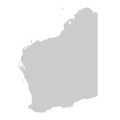Cyperus rigidellus
(Benth.) J.M.BlackSlender annual or tufted perennial, occasionally viscid. Culms triquetrous to terete, often scabrous above, 3–25 cm high, 0.6–1.3 mm diam. Leaves not septate-nodulose, mostly longer than culms, usually curly at the apex, to 3 mm wide. Inflorescence head-like or simple, with 1–4 branches 1–6 cm long; clusters dense to loose, subdigitate, hemispherical to globose, to 3 cm diam.; involucral bracts leaf-like, 2–4 much exceeding inflorescence. Spikelets flattened, 5–15 per cluster, 4–25 mm long, 2.5–4 mm wide in side view, 6–25-flowered; rachilla narrowly to broadly winged; glume spacing 1.3–2.3 mm; spikelet falling as unit, or rachilla persistent; glumes acute to obtuse with straight to excurved mucro to 0.4 mm long, with 2–3-nerved sides, straw-coloured tinged red-brown or evenly red-brown, 1.8–3.7 mm long; stamens 3; style 3-fid. Nut trigonous, narrow-obovoid to very narrow-ellipsoid, pale brown, nearly as long as glume, 1.3–3.2 mm long, 0.5–0.8 mm diam., falling with glume only if spikelet is viscid. Flowers spring–summer.
MuM, MSB, RobP. Also WA, NT, SA, Qld, NSW. Grows in ephemerally wet situations such as lake beds, floodways and roadside drains in the far north-west (e.g. Hattah, Robinvale and Jeparit areas).
A variable species that may include several taxa.
Wilson, K.L. (1994). Cyperaceae. In: Walsh, N.G.; Entwisle, T.J., Flora of Victoria Vol. 2, Ferns and Allied Plants, Conifers and Monocotyledons, pp. 238–356. Inkata Press, Melbourne.



